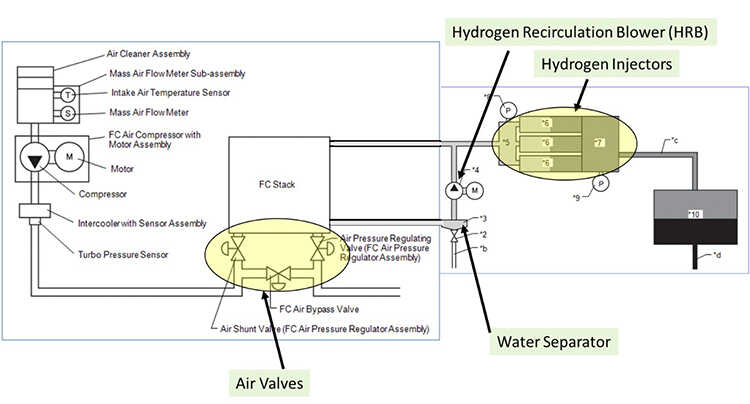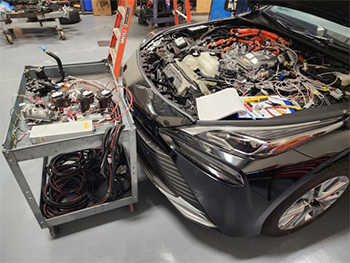Background
As the automotive industry moves towards electrification and decarbonization, fuel cell technology is emerging as a viable alternative in certain areas. Fuel cells are much more energy-dense than current state-of-the-art battery technology, making them an ideal choice for applications that require continuous high-power duty cycles. In addition, fuel cells offer a significant advantage over battery electric vehicles (BEVs), as they have similar refueling times to gasoline and diesel vehicles. These factors make them an ideal zero-tailpipe-emissions choice for Heavy-Duty (HD) and Medium-Duty (MD) applications. SwRI identified the need to develop an open controller for FCEV stacks to enable the operation of the balance of plant (BOP).
Approach
Due to the strong interest from HD/MD OEMs in fuel cell technology and the sophistication of the Mirai unit, the Powertrain Engineering Division conducted a comprehensive benchmarking of the Toyota Mirai fuel cell system as part of Phase One of the Presidential Discretion Internal Research (PDIR) Project 03.R6171. In Phase Two, the project team is in the process of developing a comprehensive model-based controller for the Mirai's fuel cell. To validate this controller, the team will run the Mirai under steady-state operating conditions and compare the results with Phase One data. Phase Two aims to yield valuable insights into Toyota's fuel cell control strategy, stack BOP, as well as thermal and humidity management strategies at the cell level.

Figure 1: Full Authority Control of Highlighted Actuators Allow Control of Hydrogen Air Stoichiometric Ratio.
Accomplishments

Figure 2: Mirai Dummy Actuator Cart.
The observer model development for control system design has been continued in this quarter. The focus of this work is to develop a controls-oriented model that can work in real time to estimate the internal state of the fuel cell membrane hydration state, thus enabling precise control of the fuel and air flow rate. This control approach enables stable power output from the fuel cell stack during transient operation and improves efficiency of the vehicle by prevention of high internal resistance of the fuel cell caused due to lack of membrane hydration.
